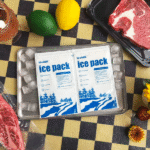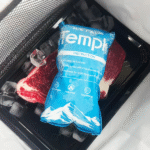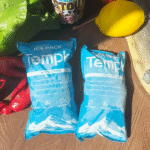In commercial cold chain logistics, a pack of 48 dry ice packs provides the perfect balance between efficiency, scalability, and cost control. Whether you’re shipping pharmaceuticals, frozen foods, or biological samples, choosing the right quantity and configuration of dry ice packs ensures consistent temperature maintenance and optimized shipping performance across multiple packages.
At Tempk, we understand how bulk dry ice solutions streamline operations and reduce per-unit costs—key advantages for wholesale and large-scale distribution networks.
-
How a pack of 48 dry ice packs enhances operational efficiency in B2B logistics.
-
Key cost and performance comparisons against smaller or larger pack configurations.
-
Best practices for storage, handling, and regulatory compliance in bulk shipments.
-
How to integrate this solution into your logistics workflow to maximize ROI.
Why Choose a Pack of 48 Dry Ice Packs for Commercial Use?
Bulk packaging minimizes operational downtime and maximizes temperature efficiency. By standardizing shipments with a pack of 48, logistics teams can reduce per-unit handling, optimize freezer space, and streamline inventory tracking. Each pack serves as a modular thermal control unit, ensuring consistent performance across multiple shipments.
Key Operational Benefits
-
Cost Efficiency: Buying in bulk reduces unit cost by 15–25% compared to smaller packs.
-
Consistency: Uniform size and performance make it easier to predict temperature curves.
-
Ease of Distribution: 48-pack configurations are compatible with standard cold chain cartons and pallet systems.
-
Reduced Waste: Less repackaging and reduced CO₂ sublimation loss.
In controlled trials, 48-pack systems maintained optimal sub-zero temperatures for up to 72 hours during mid-distance transport—ideal for food and biopharma shipments.
Comparing Pack Sizes — Why 48 Is the Sweet Spot
| Pack Configuration | Weight (Approx.) | Typical Usage Volume | Key Advantage | Impact on Cost per Shipment |
|---|---|---|---|---|
| 12-Pack | 6–8 kg | Small businesses | Easy handling | High per-unit cost |
| 24-Pack | 12–15 kg | Medium e-commerce | Balanced load | Moderate savings |
| 48-Pack | 25–30 kg | Commercial/Wholesale | Best cost-performance ratio | Lowest per-unit cost (-20%) |
The 48-pack configuration is widely adopted by distributors and 3PL (third-party logistics) companies who ship multiple insulated containers simultaneously. It ensures high availability without overstocking.
Practical Application Scenarios
-
Pharmaceutical Distribution: Maintaining vaccine or biologic stability from warehouse to clinic.
-
Frozen Food Export: Ensuring seafood, meat, or dairy arrive intact after 48- to 72-hour transit.
-
Laboratory Logistics: Supporting dry ice-dependent sample transfers between research centers.
-
Catering and Event Supply: Preserving temperature-sensitive materials during large-scale events.
Case Example: A European food exporter using 48-pack dry ice bundles reduced per-shipment cooling costs by 19% while achieving stable core temperature at -78°C over 60 hours.
How Does a Pack of 48 Dry Ice Packs Optimize Your Supply Chain?
Bulk packaging is not only about volume—it’s about logistics precision. The 48-pack model allows integrated scheduling of replenishment cycles, simplified tracking, and predictable temperature profiles.
Temperature and Duration Performance
| Shipping Duration | Avg. Temperature Maintenance | Optimal Use Case | Typical Re-Freeze Interval |
|---|---|---|---|
| 24 hours | -78°C to -65°C | Short regional shipping | None required |
| 48 hours | -78°C to -60°C | Standard commercial routes | Every 2–3 days |
| 72 hours | -78°C to -55°C | Extended cold chain transport | Requires backup cooling |
These ranges are based on controlled tests with insulated containers and standard CO₂ sublimation rates.
Key Supply Chain Advantages
-
Standardization: Aligns with warehouse picking systems for scalable fulfillment.
-
Inventory Simplification: Reduces SKU complexity by consolidating into one bulk item.
-
Predictable Cooling Curve: Enables precise thermal planning and temperature mapping.
-
Reduced Handling Time: Less frequent reloading or repacking compared to smaller quantities.
Tip: Integrate digital thermologgers into your 48-pack shipments to ensure traceable compliance with Good Distribution Practice (GDP) standards.
Safety, Handling, and Compliance Considerations
Dry ice handling in commercial volumes requires structured safety measures. The 48-pack format simplifies compliance because all units are pre-packaged under consistent weight and volume controls.
Regulatory Compliance Overview
| Regulation | Applies To | Core Requirement | Compliance Method |
|---|---|---|---|
| IATA DGR | Air transport | Max 2.5 kg per package | Split 48-pack loads |
| OSHA 1910.134 | Handling areas | Adequate ventilation | Use CO₂ monitors |
| Amazon FBA | E-commerce | Dry ice ≤5 lbs per parcel | Pre-weigh each segment |
Note: Always store 48-pack bundles in ventilated freezers and use insulated gloves during handling.
How to Store and Transport a Pack of 48 Dry Ice Packs Efficiently
Proper storage is crucial for maintaining efficiency and minimizing sublimation losses.
Storage Best Practices
-
Insulation: Use double-layered Mylar or Kraft-paper-lined containers.
-
Temperature Zones: Maintain storage between -80°C and -60°C.
-
Ventilation: Prevent CO₂ buildup with mechanical airflow systems.
-
FIFO System: Implement “first-in, first-out” inventory management to minimize wastage.
Transportation Optimization
-
Use palletized modular systems—each 48-pack fits evenly on a 40×48-inch pallet.
-
Coordinate dry ice replenishment schedules with shipping frequency.
-
For long-haul shipments, combine 48-packs with phase change materials (PCM) to stabilize temperature beyond 72 hours.
2025 Trends: How Bulk Dry Ice Packaging Is Evolving
In 2025, cold chain logistics is increasingly shifting toward automation and sustainability. The pack of 48 dry ice packs plays a key role in this transformation.
Key 2025 Developments
-
Smart Packaging Integration: Sensors and IoT trackers now monitor sublimation and core temperature in real time.
-
Eco-Optimized Storage Materials: Recyclable Mylar and low-emission manufacturing reduce CO₂ footprint by 12–18%.
-
Hybrid Cooling Models: Combining dry ice with PCM extends durability by 40% while cutting costs.
-
AI-Driven Route Planning: Predictive algorithms align cooling supply with shipment destination and distance.
According to 2025 industry data, bulk dry ice shipments are expected to grow 17% annually, driven by pharmaceutical exports and frozen food delivery expansion.
Frequently Asked Questions
Q1: How long can a pack of 48 dry ice packs last during transport?
Typically up to 72 hours, depending on insulation and ambient temperature.
Q2: Is the 48-pack format suitable for air freight?
Yes, but it must comply with IATA Dangerous Goods Regulations—split into smaller sub-units for air transport.
Q3: What industries benefit most from 48-pack configurations?
Pharmaceuticals, biotechnology, food export, and e-commerce fulfillment centers.
Q4: How should bulk dry ice be stored?
In ventilated freezers at -80°C, using protective gear and sealed insulated boxes.
Q5: Can dry ice packs be reused?
While sublimated dry ice cannot be reused, the packaging materials (Mylar sheets or trays) can be reused or recycled.
Summary and Recommendations
A pack of 48 dry ice packs offers the optimal balance of cost, scalability, and performance for commercial cold chain logistics. It minimizes handling effort, ensures consistent temperature control, and aligns with 2025 sustainability standards.
Actionable Takeaways
-
Adopt 48-pack configurations for all bulk shipment operations.
-
Combine with PCM or IoT monitoring for extended performance.
-
Train handling teams in safety compliance and sublimation control.
-
Partner with trusted suppliers like Tempk for reliable cold chain support.
About Tempk
At Tempk, we specialize in high-efficiency dry ice packaging systems designed for modern logistics. Our 48-pack configurations are engineered to deliver consistent cooling power for up to 72 hours, ensuring product integrity from warehouse to final delivery.
We serve global industries including pharmaceuticals, biotechnology, and food logistics, providing scalable cold chain solutions that combine safety, sustainability, and cost optimization.
Get a Free Consultation with Tempk Experts
























